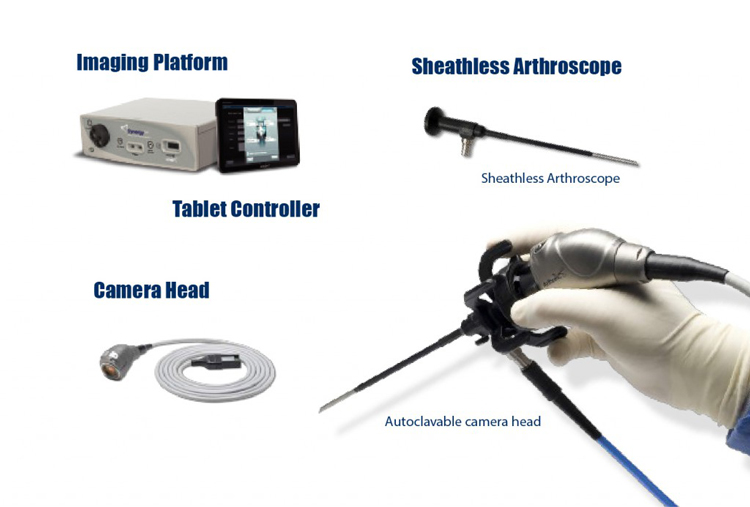Arthroscopy is a minimally invasive procedure, which is used to diagnose and treat conditions of the knee, hip, elbow, ankle or shoulder. Arthroscopy in FV Hospital’s Orthopaedics Department is done with support of high definition (HD), 3 chip CCD camera system and an advanced LED light source, providing detailed images to assist surgeons in all procedures.

A common condition that can be treated using arthroscopy is arthritis, an example being synovitis, which involves inflammation of the lining in the knee, shoulder, elbow, wrist, or ankle. Arthroscopy can also treat acute or chronic injury associated with the joint, such as :
- Shoulder: Rotator cuff tendon tears, impingement syndrome, and Bankart lesions
- Knee: Meniscal (cartilage) tears, chondromalacia (wearing or injury of cartilage cushion), and anterior/posterior cruciate ligament tears with instability
- Wrist: Carpal tunnel syndrome
Although the inside of nearly all joints can be viewed through arthroscopy, six joints are examined with this procedure more frequently. These include the knee, shoulder, elbow, ankle, hip, and wrist. Initially, arthroscopy was simply a diagnostic tool for planning standard open surgery. With development of better instrumentation and surgical techniques, many conditions can be treated arthroscopically. For instance, most meniscal tears in the knee can be treated successfully with arthroscopic surgery.
Mr Adam Henrique Ford, a 28 year old English teacher living in Nha Be District, HCMC, had the inner lining of his meniscal tear when he was playing football. Adam visited FV Hospital as his knee was swollen and he could not stretch out his leg. After directly providing consultation and examination to Adam and performing all needed investigational tests, Dr Le Trong Phat (PhD.), Head of Orthopaedic Department, decided to perform arthroscopic treatment.
FV Hospital’s Orthopaedics Department, utilise the modern Stryker arthroscopy system to support them when performing surgery to patients. This arthroscopy system is recognised as a revolutionary imaging system. It consists of a commanding imaging platform that features an arthroscope with a 1080p HD programmable camera, a LED light source, an image management system, and an all in one tablet controlled device, which allows surgeons to view live images extremely clear.
The arthroscope’s camera has a compact, comfortable and ergonomic design that enables optimal angulation. The ultrathin sheathless arthroscope of 3-4mm external diameter facilities insertion to small cavities of joints and provides better observation for surgeons.
The sheathless arthroscope has revolutionised the way arthroscopic procedures are performed. By eliminating a bulky scope sheath, obturators, and switching sticks; viewing portal changes are quick and efficient. The sheathless arthroscope will also help to minimise the time for surgery.
To perform arthroscopy on Adam, Dr Phat made two small incision of around 5-7 mm to insert the arthroscope. The inner lining of Adam’s meniscus was so torn that it could not be stitched up and Dr Phat decided to remove the torn part completely.
These incisions were stiched up and banded after the procedure. Mr Adam then was transferred from the operating room to the recovery room and was givenpain medication. No hospitalisation was needed in his case and Adam only stayed in the Day Ward before going home several hours following the procedure.
Although the puncture wounds are small and pain in the joint that underwent arthroscopy is minimal, it takes several weeks for the joint to completely recover. In the case of Adam, Dr Phat advised some activities or rehabilitation programmes to speed up the recover and protect the function of the joint in the future. Now, Adam has totally recovered after a series of routine physiotherapy sessions. His life has returned to normal, even being able to continue doing his favourite sports, such as gym, football, boxing and Kenjutsu fencing.
It is not unusual for patients to go back to work or school or resume daily activities within a few days. Athletes and others who are in good physical condition may in some cases return to athletic activities within a few weeks.
Dr Phat said: “For the patients who do not respond to non-surgical treatment, arthroscopy is an effective option for them. Almost all of the patients who underwent arthroscopy experience no future complications. With the effective support from the modern Arthroscopy system, we can perform arthroscopic procedures with higher accuracy and optimise the outcome of the treatment”.



